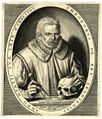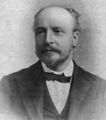|
|
| (7 intermediate revisions by the same user not shown) |
| Line 1: |
Line 1: |
| <gallery> | | <gallery> |
| ||1572: Girolamo Maggi dies ... polymath. No DOB. Pic search dubious: https://www.google.com/search?q=Girolamo+Maggi | | File:Theodor de Bry self portrait 1597.jpg|1598: Engraver, goldsmith, and publisher '''[[Theodor de Bry (nonfiction)|Theodor de Bry]]''' dies. de Bry gained fame for his depictions of early European expeditions. Although de Bry never visited the Americas, most of his books are based on first-hand observations by explorers. |
|
| |
|
| ||1598: Theodor de Bry dies ... engraver, goldsmith, and publisher. No DOB. Pic. | | File:Wilhelm Röntgen.jpg|link=Wilhelm Röntgen (nonfiction)|1845: Engineer and physicist '''[[Wilhelm Röntgen (nonfiction)|Wilhelm Röntgen]]''' born. He will win the first Nobel Prize in Physics, for the discovery of X-rays. |
|
| |
|
| ||1809: Georges-Eugène Haussmann born ... engineer, urban planner, and politician. Pic. | | File:James Dewar.jpg|link=James Dewar (nonfiction)|1923: Chemist and physicist '''[[James Dewar (nonfiction)|James Dewar]]''' dies. He invented the vacuum flask, which he used in conjunction with extensive research into the liquefaction of gases. |
|
| |
|
| ||1824: Johann Wilhelm Hittorf born ... physicist who was born in Bonn and died in Münster, Germany. Hittorf was the first to compute the electricity-carrying capacity of charged atoms and molecules (ions), an important factor in understanding electrochemical reactions. He formulated ion transport numbers and the first method for their measurements. Pic. | | File:Carl Gottfried Neumann.jpg|link=Carl Gottfried Neumann (nonfiction)|1925: Mathematician '''[[Carl Gottfried Neumann (nonfiction)|Carl Gottfried Neumann]]''' dies. He will studied physics with his father, and later worked as a mathematician, dealing almost exclusively with problems arising from physics. |
|
| |
|
| ||1929: Samuil Shatunovsky dies ... mathematician. He worked on several topics in mathematical analysis and algebra, such as group theory, number theory and geometry. Independently from Hilbert, he developed a similar axiomatic theory and applied it in geometry, algebra, Galois theory and analysis. Pic.
| | File:George Tooker.jpg|link=George Tooker (nonfiction)|2011: Artist '''[[George Tooker (nonfiction)|George Tooker]]''' dies. Tooker's paintings depicted his subjects naturally, as in a photograph, but the images used flat tones, an ambiguous perspective, and alarming juxtapositions to suggest an imagined or dreamed reality. |
| | |
| ||1836: Texas Revolution: On the orders of General Antonio López de Santa Anna, the Mexican army massacres 342 Texas POWs at Goliad, Texas.
| |
| | |
| File:Wilhelm Röntgen.jpg|link=Wilhelm Röntgen (nonfiction)|1845: Engineer and physicist [[Wilhelm Röntgen (nonfiction)|Wilhelm Röntgen]] born. He will win the first Nobel Prize in Physics, for the discovery of X-rays.
| |
| | |
| ||1847: Otto Wallach born ... chemist and academic, Nobel Prize laureate. Pic.
| |
| | |
| ||1850: Wilhelm Beer dies ... astronomer and banker.
| |
| | |
| ||1854: Giovanni Battista Grassi born ... physician, zoologist, and entomologist.
| |
| | |
| ||1855: William Libbey born ... target shooter, colonel, mountaineer, geographer, geologist, and archaeologist.
| |
| | |
| ||1855: James Alfred Ewing born ... physicist and engineer, best known for his work on the magnetic properties of metals and, in particular, for his discovery of, and coinage of the word, hysteresis. Pic.
| |
| | |
| ||1857: Karl Pearson born ... mathematician, eugenicist, and academic. Pic.
| |
| | |
| ||1863: Henry Royce born ... engineer and businessman, founded Rolls-Royce Limited.
| |
| | |
| ||1873: Tommy Bonnesen born ... mathematician, known for Bonnesen's inequality. Pic.
| |
| | |
| ||1882: Thomas Graham Brown born ... mountaineer and physiologist.
| |
| | |
| ||1884: A mob in Cincinnati, Ohio, attacks members of a jury which had returned a verdict of manslaughter in what was seen as a clear case of murder; over the next few days the mob would riot and eventually destroy the courthouse.
| |
| | |
| ||1888: The Blessed Francesco Faà di Bruno dies ... priest and advocate of the poor, a leading mathematician of his era and a noted religious musician. In 1988 he was beatified by Pope John Paul II. He is the eponym of Faà di Bruno's formula. Pic.
| |
| | |
| ||1890: Carl Jacob Löwig dies ... chemist and academic. Löwig discovered bromine independently of Antoine Jérôme Balard. Pic.
| |
| | |
| ||1897: Douglas Hartree born ... mathematician and physicist ... development of numerical analysis and its application to the Hartree-Fock equations of atomic physics and the construction of the meccano differential analyzer. Pic.
| |
| | |
| ||1897: Fred Keating born ... magician, stage and film actor.
| |
| | |
| ||1899: Herbert Arthur Stuart born ... physicist and academic.
| |
| | |
| ||1899: Francesco Castracane degli Antelminelli dies ... naturalist. He was reportedly one of the first to introduce microphotography into the study of biology. His first experiments in applying the camera to the microscope were made as early as 1862 with diatomaceæ, and he subsequently made these microorganisms his chief study. Pic: https://www.europeana.eu/portal/en/record/2023813/https___phaidra_cab_unipd_it_o_1480.html
| |
| | |
| ||1902: Émile Benveniste born ... linguist and semiotician.
| |
| | |
| ||1905: László Kalmár born ... mathematician and Professor at the University of Szeged. Kalmár is considered the founder of mathematical logic and theoretical computer science in Hungary.
| |
| | |
| ||1905: Rudolf Christoph Freiherr von Gersdorff born ... officer in the German Army. He attempted to assassinate Adolf Hitler by suicide bombing on 21 March 1943; the plan failed when Hitler left early, but Gersdorff was undetected. Pic.
| |
| | |
| ||1910: John R. Pierce born ... engineer and author ... TV radio sound. Pic (cool).
| |
| | |
| ||1910: Alexander Emanuel Agassiz dies ... ichthyologist, zoologist, and engineer.
| |
| | |
| File:James Dewar.jpg|link=James Dewar (nonfiction)|1923: Chemist and physicist [[James Dewar (nonfiction)|James Dewar]] dies. He invented the vacuum flask, which he used in conjunction with extensive research into the liquefaction of gases.
| |
| | |
| ||1924: Margaret K. Butler born ... mathematician and computer programmer. Pic: https://www.anl.gov/article/in-memoriam-the-remarkable-career-of-margaret-butler
| |
| | |
| File:Carl Gottfried Neumann.jpg|link=Carl Gottfried Neumann (nonfiction)|1925: Mathematician [[Carl Gottfried Neumann (nonfiction)|Carl Gottfried Neumann]] dies. He will studied physics with his father, and later worked as a mathematician, dealing almost exclusively with problems arising from physics.
| |
| | |
| ||1924: Charlotte Cynthia Barnum dies ... mathematician and social activist, was the first woman to receive a Ph.D in mathematics from Yale University. No pic (tried), but visit library, try harder, she is interesting.
| |
| | |
| ||1945: Vincent Hugo Bendix dies ... engineer and businessman, founded Bendix Corporation.
| |
| | |
| ||1954: Nuclear weapons testing: The Romeo shot of Operation Castle is detonated at Bikini Atoll. Yield: 11 megatons.
| |
| | |
| ||1967: Jaroslav Heyrovský dies ... chemist and academic, Nobel Prize laureate.
| |
| | |
| File:George E P Box.jpg|link=George E. P. Box (nonfiction)|1975: Statistician [[George E. P. Box (nonfiction)|George E. P. Box]] publishes new class of [[Gnomon algorithm functions]], based on time-series analysis and Bayesian inference, which detect and prevent [[crimes against mathematical constants]].
| |
| | |
| ||1968: Yuri Gagarin dies ... Russian colonel, pilot, and astronaut.
| |
| | |
| ||1977: Tenerife airport disaster: Two Boeing 747 airliners collide on a foggy runway on Tenerife in the Canary Islands, killing 583 (all 248 on KLM and 335 on Pan Am). Sixty-one survived on the Pan Am flight. This is the worst aviation accident in history.
| |
| | |
| ||1980: Silver Thursday: A steep fall in silver prices, resulting from the Hunt Brothers attempting to corner the market in silver, leads to panic on commodity and futures exchanges.
| |
| | |
| ||1993: Italian former minister and Christian Democracy leader Giulio Andreotti is accused of mafia allegiance by the tribunal of Palermo.
| |
| | |
| ||2007: Paul Lauterbur dies ... chemist and biophysicist ... shared the Nobel Prize in Physiology or Medicine in 2003 with Peter Mansfield for his work which made the development of magnetic resonance imaging (MRI) possible. Pic.
| |
| | |
| File:George Tooker.jpg|link=George Tooker (nonfiction)|2011: Artist [[George Tooker (nonfiction)|George Tooker]] dies. His paintings depicted his subjects naturally, as in a photograph, but the images used flat tones, an ambiguous perspective, and alarming juxtapositions to suggest an imagined or dreamed reality. | |
| | |
| File:Diagramaceous soil bingo algorithm harvest.jpg|link=Diagramaceous soil|2002: Tokens harvested from [[Diagramaceous soil]] used to detect and prevent [[crimes against mathematical constants]].
| |
| | |
| ||2017: Theoretical chemist and academic Robert Parr dies. Working with DuPont chemist Rudolph Pariser, Parr developed a method of computing approximate molecular orbitals for pi electron systems, published in 1953. Since an identical procedure was derived by John A. Pople the same year, it is generally referred to as the Pariser-Parr-Pople method or PPP method. The PPP method differed from existing structural chemistry thinking by advancing the concept of zero differential overlap approximation. Pic search yes: https://www.google.com/search?q=Robert+Parr
| |
|
| |
|
| </gallery> | | </gallery> |




